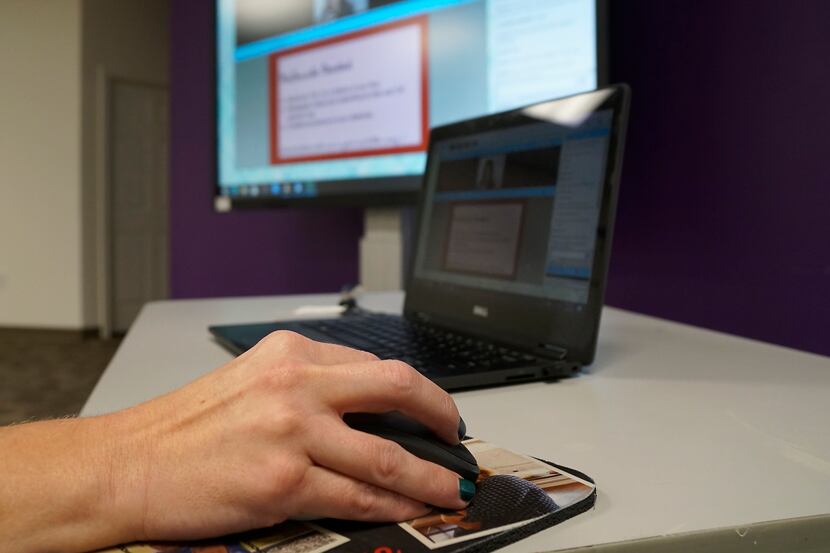Kaye Rogers’ phone began to ring and her inbox filled with questions about virtual learning before Texas schools shut down because of the coronavirus.
School leaders from across the state sought advice on teacher training, how to transition curriculum and what pitfalls to avoid as students began learning from home.
Rogers has overseen iUniversity Prep, Grapevine Colleyville ISD’s virtual school, for almost a decade. She and her staff are seen as the experts in teaching kids from a distance.
“It’s really different being a virtual teacher versus a ‘bricks and mortar’ teacher,” Rogers said. “The difference that sets us apart is about our bottom line of students first and … building those relationships, being available to kids.”
When campuses suddenly began shutting down last March, school administrators scrambled to figure out how they could educate Texas’ 5.4 million students without seeing them in person.
There weren’t many examples of high-performing virtual campuses to look to for inspiration or best practices. Texas’ other virtual campuses have struggled to perform well on the state’s A-F accountability system.
And they aren’t alone in showing poor academic results. A 2015 Stanford study that looked at the performance of students in online charter schools found that the majority lost learning equivalent to a standard 180-day school year.
But iUniversity Prep students routinely outperformed the rest of Texas on state exams; recorded perfect attendance; and excelled in advanced academic courses. It’s one of the state’s only virtual schools operated by a traditional district.
The campus is also different as it was designed as a magnet school with admission requirements for students. These students tend to be self-motivated, seeking out virtual education to accommodate their commitments outside of class, such as intense athletic schedules to erratic acting gigs.
Other virtual schools are often run through for-profit vendors and welcome any Texas-based student.
Rogers admits her school is unique but notes it also relies on the same fundamentals that many “brick and mortar” campuses are built on: strong student engagement; teachers who excel at building relationships; and quality training for everyone who embarks on a new way of learning.
“We can have kids that have been face-to-face with us all year long and they weren’t engaged,” Rogers said. “We can have kids that are virtual and they are incredibly engaged, but we’ve never met them face-to-face.”
Figuring out how to do the latter makes a big difference, she said.

Engaging with students
Each day, iUniversity Prep’s students log into classes from their homes across the Dallas metroplex, in Beaumont, San Antonio and beyond.
These students are Texas-based and don’t have any requirements to meet their classmates or teachers in person.
Still, iUniversity Prep leaders believe that personal connections are important. So they look for ways students can engage within the school community.
In more normal times, the school hosts face-to-face club meet-ups around Texas. A robotics competition might draw iUniversity Prep students to Austin, for example, or a running club might gather for a race in Houston.
In the current environment, those meet-ups occur online so students still have the opportunity to socialize outside of class.
There aren’t as many opportunities for students to get to know their instructors informally — they can’t stop into their classroom during lunch or chat with them in a passing period. So teachers receive substantial training on how to build relationships with students from afar.
Interactions are intentional by necessity.
Teacher Tina Alwin noted that virtual teachers use the unique setting to their advantage. Even when she’s instructing a student from a distance, she learns about them and their home environment.
“We are part of their daily life,” Alwin said. “We’re sitting in their home when we’re working and helping them.”
She often finds herself in conversation with students about their pet parakeet or their job at Whataburger. Without the more intimate setting, Alwin might not know about those details.
Rogers emphasized that successful teachers learn to structure their time a little differently and make themselves available to kids outside of the class period.
While educators have synchronous class periods where students log on at the same time as their instructors, they also hold office hours to meet with students one-on-one when necessary.
And successful teachers recognize a student’s need for flexibility, so they work with students when they ask for help outside of the school day.
Extensive training and preparation
A teacher switching from in-person to virtual instruction can’t just transform their lectures into PowerPoint presentations, educators from iUniversity Prep say.
Those who excel online must learn how to be intentional and proactive when engaging with students and adapting lessons.
iUniversity Prep strives to hire teachers who are already “masters of their craft,” but Rogers said educators also need consistent support on best practices. So new teachers participate in a yearlong mentorship program.
Spanish teacher Andres Betancur made the transition from in-person to online instruction almost a decade ago. It was a big shift in mentality, he said.
He had to switch from what he called a binary to a team mindset. During face-to-face teaching, he designed a lesson, delivered it and then tested students on their understanding of it. That felt adversarial at times, he noted.
Online, he began to feel like it was more of a collaboration. He and his student would work together to complete coursework. They had the joint goal of getting through the lessons with much of his effort spent on supporting students so they didn’t have to rely on him.
“The internal motivations of a teacher has to be different or evolved,” Betancur said.
Southern Methodist University professor Jennifer Culver is an expert in training teachers for this transition. She developed a virtual teacher certification program in 2015.
Through that program, teachers learned to foster an environment of active learning where students could discuss complex topics with one another instead of just passively taking a course. They also learned to develop clear communication plans that allowed students to know exactly how to reach an instructor and get the needed support.
The teachers that excelled in virtual learning were those who had the ability to pivot and be flexible in lesson planning, Culver said. Successful instructors also were able to gauge the responsiveness of students both formally through assessments and informally through check-ins.
Successful student characteristics
Even with hours of preparation and training, virtual learning won’t meet the needs of every student. It should never be a one-size-fits-all solution, longtime virtual educators like Rogers say.
The students at iUniversity Prep tend to be successful because they’ve chosen this path for themselves, they said.
Ian Kirk enrolled at iUniversity Prep four years ago so he’d have more time for figure skating. The sport required a lot of travel and a sizeable financial investment.
“We needed something that wasn’t like a crazy, private school,” Kirk said, noting the importance of a free education. “We went to iUP just for the flexibility for skating with my traveling and with day-to-day practice.”
Student athletes often enroll in virtual school to fit more time into their day for practice. They might start their day working out, take a break in the middle for schoolwork, return to practice in the early evening and revisit their academics at night. Virtual education allows athletes to shuffle their schedules around workouts.
Anastasia Mayes enrolled in online education after her family moved to a new home far away from even the closest campus. She and her family thought it would be better to log on to class from home rather than spending an hour or more on a school bus waiting to arrive on campus.
Other students have opted for the virtual setting because they haven’t found a good fit in a traditional environment or needed more time at home because of medical issues.
Full-time virtual education isn’t so different from other unique offerings like a STEM-focused school or dual language program, Rogers said. Any specialized offering tends to draw a more distinctive student population.
Students drawn to virtual learning typically opt in because their needs haven’t been met in a traditional schooling environment. They might have a health condition that makes attending class in a rigid schedule a challenge or have social anxieties that make an on-campus experience undesirable.
All of iUniversity Prep’s students have to meet the criteria for admission to the magnet program: they must be on grade level, have passed previous STAAR exams and be in good standing for attendance and discipline.
Before students log into their first classes, they must go through 20 to 30 hours of preparation that covers what to expect: the technology they’ll use; how to engage with teachers; and what kind of family support is necessary to be successful.
The school asks parents to stay home with their children as they learn online. A fifth grader left alone to work through their classwork, for example, will likely struggle, Rogers said.
The choice to log in and participate is essential to the school’s success, Betancur said. Each time someone logs in, they are choosing to engage in class and in a discussion.
Just because someone is attending class in person “doesn’t mean that you’re there engaged, and present, bright-eyed,” Betancur said.
That’s a big difference schools must account for if they are trying to mirror Rogers’ model.
It feels like such a notable caveat that Rogers doesn’t even use the same vocabulary to describe the two.
Virtual learning describes what the Texas Education Agency has approved as a full-time virtual school. That’s what iUniversity Prep does, Rogers said. Online learning is what brick and mortar schools have stood up in the wake of the pandemic to accommodate kids who want to stay at home.
The factors that lead to success in both methods are similar, but the conditions students deal with outside the classroom aren’t the same.
Stay connected to the latest in education by signing up for our weekly newsletter.
This story is a part of Learning from Lockdown, a series about education solutions in the pandemic, produced in partnership with the Education Labs at AL.com, the Dallas Morning News, Fresno Bee and The Seattle Times partnered with the Christian Science Monitor, Hechinger Report and Solutions Journalism Network.
The DMN Education Lab deepens the coverage and conversation about urgent education issues critical to the future of North Texas.
The DMN Education Lab is a community-funded journalism initiative, with support from The Beck Group, Bobby and Lottye Lyle, The Communities Foundation of Texas, The Dallas Foundation, Dallas Regional Chamber, Deedie Rose, The Meadows Foundation, Solutions Journalism Network, Southern Methodist University and Todd A. Williams Family Foundation. The Dallas Morning News retains full editorial control of the Education Lab’s journalism.

